First Fleet
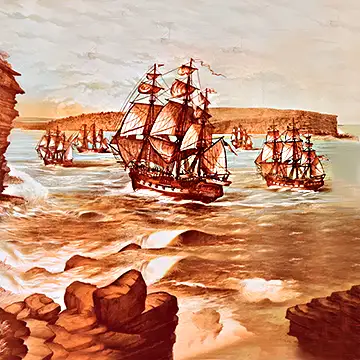
Photo: First Fleet arriving in Australia
Contents
What Was The First Fleet?
The First Fleet was a convoy of 11 ships that set sail from Portsmouth, England, on 13 May 1787, on a gruelling 24,000-kilometre journey to establish the first British colony in Australia. After eight months at sea, navigating treacherous waters and extreme conditions, the fleet arrived at Botany Bay on 18 January 1788, marking the beginning of European settlement on the Australian continent.
On board these ships were 736 convicts, including children, along with 211 Royal Marines, their families, and roughly 300 officers and crew members. Among the convicts was John Hudson, an 11-year-old chimney sweep sentenced to seven years in prison when he was just eight years old. His poignant story reflects the harsh realities of life in those days and the human cost of colonization. Discover the dramatic journey, the people who endured it, and how the First Fleet forever changed Australia's history.
Background: Why Convicts Were Sent to Australia
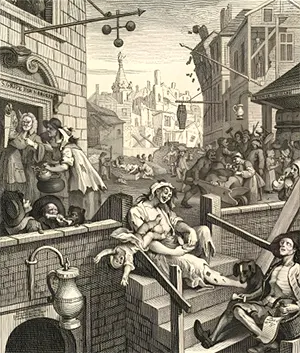
Photo: Poor people around Gin Lane in London – a
reflection of 18th-century urban life
Great Britain in the 1770s and 1780s was a harsh and unforgiving place. The Industrial Revolution, while a catalyst for economic growth, wreaked havoc on rural communities. Traditional jobs disappeared, replaced by machines, forcing thousands to flood into already overcrowded cities like London, Birmingham, and Manchester. These urban centres quickly became breeding grounds for poverty, disease, and crime. This, together with the availability of cheap alcohol – namely gin, inevitably led to a massive increase in crime.
To maintain control, the British legal system imposed incredibly harsh penalties for crime, with over 200 offences that carried a mandatory death penalty. Even petty crimes such as burglary, theft, or chopping down a tree were punishable by death. This era became infamously known as the time of the "Bloody Code."
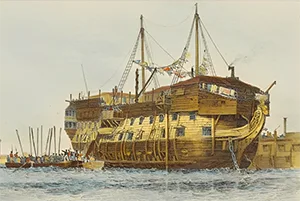
Photo: An old prison hulk moored on the
Thames, used as a floating jail for overcrowded
British prisons
But as public opinion shifted, courts began to resist the severity of these laws. Judges and juries increasingly sought to avoid executing people for petty crimes by undervaluing stolen items or finding alternative charges. As a result, more convicts were being jailed rather than hanged, resulting in severe overcrowding of its prisons. The situation was so bad that convicts were being housed in derelict old ships, known as 'hulks', that had been converted into floating jails. Conditions on these floating jails were horrific. In some instances, nearly 300 prisoners were crammed into a hulk just 65 meters in length (about 6 bus-lengths). In these overcrowded and filthy conditions, over 30% of the convicts died from diseases.
Public outrage grew. The British government was caught in a dilemma: it couldn't resume mass executions for fear of backlash, and it couldn't build enough prisons to contain the growing number of inmates.
The solution they came up with was penal transportation.
What was Penal Transportation?
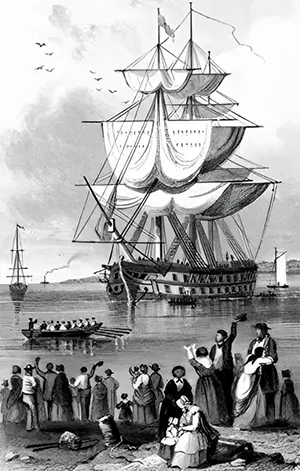
Photo: Well-wishers farewelling the First Fleet
Transportation meant sending convicted criminals, often for petty theft, to distant parts of the British Empire to serve out their sentences in servitude. For many, this punishment was a death sentence in disguise, while for others, it was a chance for a new life in an unknown land.
Up until American Independence, Britain relieved some of the pressure on its prisons by transporting over 52,000 convicts to its American colonies. However, with the loss of these colonies, as a result of American independence, meant that prisoners who had previously been earmarked for America were now also being housed in overcrowded prison hulks. Canada, a British colony at the time, refused to accept convicts. Another idea was to transport convicts to sugar plantations in the British colonies in the Caribbean. The plantation owner squashed that idea because it was more economical for them to use black slaves than white convicts, who would cost them more, demand more rights, and possibly cause them trouble.
How Australia was Chosen for Convict Resettlement

Photo: Joseph Banks
By 1784, the British government was in desperate need of a solution to its dangerously overcrowded prisons. Renowned botanist Joseph Banks, who had sailed with Captain James Cook during his 1770 exploration of the east coast of Australia, proposed a radical idea. Banks suggested Botany Bay in New South Wales as the perfect site for a new penal colony. Cook had already claimed the land for Britain, and Banks saw an opportunity to not only relieve the burden on British jails but also to stake a claim on Australia before rival powers like France could do so.
The British government embraced the proposal, since it offered a convenient solution to domestic prison overcrowding while also furthering its imperial ambitions in the Pacific. On 18 August 1786, the decision was made. A fleet would be sent to Australia to establish a penal colony at Botany Bay, populated by convicts, their military guards, and government officials.
Just weeks later, on 1 September 1786, the British government placed newspaper advertisements seeking ships to carry out the mission. The contract was awarded to ship-broker William Richards for the considerable sum of £54,000 (about $6 million AUD today). However, from its very inception, the First Fleet venture was plagued by poor planning and logistical challenges that would test everyone involved.
When Did the First Fleet Leave England?
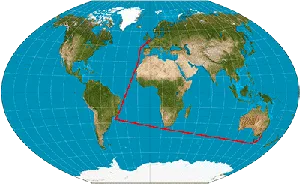
Photo: Map of the route taken by the First Fleet
The First Fleet, consisting of eleven ships, departed from Portsmouth, England, on the 13th of May 1787, with two years of supplies and 1420 people on board. The little flotilla was under the command of Arthur Phillip, a junior naval officer who was to be the future governor of the soon-to-be-established penal colony in Australia.
The people on board consisted of: 736 convicts, 17 children of convicts, 211 marine guards, 27 marines' wives, 14 children of marines, and about 300 officers and ships' crew.
This fleet sailed from Portsmouth to Tenerife, then to Rio de Janeiro, and from there, they set across the Atlantic through the Cape of Good Hope to Cape Town and on to Australia. The journey took eight months. The distance the ships travelled was 24,000 km. During their voyage, there were 104 deaths and 20 births on board.
Convicts of the First Fleet How Many Convicts on the First Fleet?
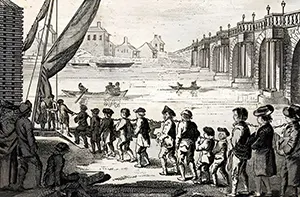
Photo: Convicts marched onto the First Fleet
The exact number of convicts transported on the First Fleet varies between 756 and 789. It appears that 789 convicts were shipped out from England. The lower number of 756 seems to be the number of persons who actually arrived in Australia. This number is derived by taking into account the 43 deaths and 22 births amongst the convicts during the voyage to Australia. So 789 convicts left England, and 754 convicts and their newborn children arrived in Australia.
How Many Convicts were on the First Fleet?
|
|
Left England |
Arrived in Australia |
| Convicts (men) | 582 | 543 |
| Convicts (women) | 193 | 189 |
| Convicts' children | 14 | 11 + 11 born |
| Total | 789 | 754 |
Where Were the Convicts From?
The vast majority of convicts transported to Australia were from England and Wales (70%), Ireland (24%), and Scotland (5%). However, there were also convicts from America (including blacks), India, Canada, Hong Kong, and the Caribbean.
Most convicts were from the cities and sentenced for larceny, which at the time included burglary, robbery, fraud, theft, and similar crimes. The average age was 29 years, and the median age was 27 years.
The Youngest and Oldest Convicts on the First Fleet
The youngest convict was John Hudson, an 11-year-old chimney sweep. John was only 8 years old when he was sentenced to 7 years imprisonment. His crime is unrecorded, but it was probably for robbery. Given that he was transported at such a young age, he may have been a repeat offender.
The oldest convict transported aboard the First Fleet was Elizabeth Beckford, who was 75 years old and died on the voyage. The oldest convict to arrive in Australia was Joseph Owen. He was 68 years old.
When Did the First Fleet Arrive in Australia?
The First Fleet, led by HMS Supply, sailed into Botany Bay in New South Wales on the 18th of January 1788.
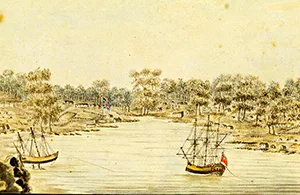
Photo: First Fleet entering Sydney Cove
The original intention was to establish the new settlement at Botany Bay. However, after just three days, Captain Phillip realised that it wasn't a suitable place for settlement. The reasons for his decision were the lack of a suitable supply of freshwater, the poor quality of the soil, and the bay was too exposed to the sea with strong winds, which didn't provide a safe harbour for his ships.
While the ships of the fleet, with their human cargo, remained anchored at Botany Bay, a scouting party set out in search of a more suitable location for the new settlement. They visited a site just 12 kilometres to the north that James Cook had named Port Jackson nearly 18 years earlier. They spent three days there before selecting an area Phillip named Sydney Cove in honour Thomas Townshend, 1st Viscount Sydney, the British Home Secretary. This location had an excellent natural harbour and a stream with a reliable water supply. Philip and his team then returned to the waiting fleet at Botany Bay.
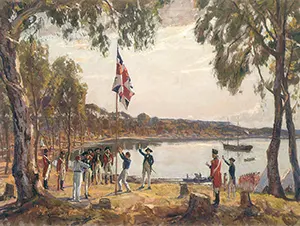
Photo: Raising the Union Jack flag at Sydney Cove
Philip returned to Sydney Cove on 26 January 1788, officially came ashore, raised the British Flag, and took possession of the area in the name of the British government. We know this location today as the city of Sydney, and we celebrate the 26th of January as "Australia Day".
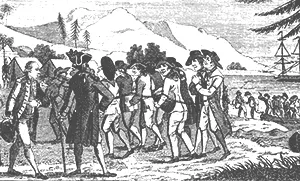
Photo: Convicts coming ashore at Sydney Cove
The first convicts came ashore in Australia on 27 January 1788.
On 7 February 1788, Phillip officially read out his commission from the British government, founding the colony of New South Wales and becoming its first governor. He reaffirmed Great Britain's claim of all of the land from the Pacific Ocean westward to the 135th meridian east between latitudes of 10°37'S and 43°39'S.
An inventory taken by Phillip recorded that his little colony consisted of 1030 Europeans, 7 horses, 29 sheep, 74 swine (pigs and hogs), 5 rabbits, 7 cattle, 18 turkeys, 29 geese, 35 ducks, 122 fowls, 87 chickens, 19 goats, provisions to last two years and tools to establish a settlement. One bull and 4 cows strayed from the settlement and were lost, only to be found alive 7 years later.
Life in the new settlement was very hard, and most of the people didn't have the skills (like farming, carpentry, etc.) to tame the new land. Starvation was always a major problem.
There Will Be No Slavery in Australia The Rule of Law
When establishing his settlement, Governor Arthur Phillip declared that the European inhabitants of the colony would enjoy all the rights and responsibilities under English Law. He also declared that 'There will be no slavery in the new colony and hence no slaves'. This edict was godsent for the native Aboriginal people. While they were to suffer terribly as a consequence of white settlement, they were never enslaved as was the case in America, for example.
Australia’s First Police Force were Criminals
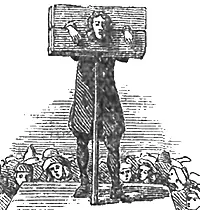
Originally, the Royal Marines who accompanied the first fleet were put in charge of law enforcement, but crime soon began to increase in the new colony. But due to a scarcity of manpower, Governor Phillip had no choice but to employ the 12 best-behaved convicts to form his first police force, known as the Night Watch.
The First Court Case in Australia
The first court case in the new colony was by Henry Kable and his wife Susannah, who claimed that Duncan Sinclair, the captain of the convict transport ship the Alexander, had stolen their belongings during the voyage to Australia.
In Britain, convicts had no rights, and Sinclair boasted that a criminal could not sue him in a court of law. Unfortunately for Sinclair, the court in Australia thought otherwise and ordered that Sinclair pay restitution to Henry and Susannah Kable for the stolen goods. This was a clear indication that the new colony was on the path to a more egalitarian and democratic society than the mother country.
Henry Kable went on to become a successful businessman and landowner in the new colony.
Ownership and Distribution of Land "Terra Nullis"
Terra nullis is a Latin term from ancient Roman law, meaning "nobody's land". Many European colonialists and imperialists conveniently adopted this concept to justify the occupation of foreign lands they settled in. Even though the native Aborigine people had lived on the land for over 50,000 years, because they were hunter-gathers and did not have permanent settlements; the British conveniently declared them to be uncivilised and did not own any land. On this pretext, they declared that all land in the new colony was Crown Land. That is, public land owned by the British government.
In order to expand the colony and make it self-sufficient, the government actively gave away crown land to ex-convicts and marines on the proviso that they demonstrated that it would be used for some productive purpose. Because of this condition of use, only small parcels of land were distributed in the first five years or so of settlement.
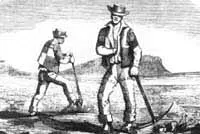
Photo: Tilling the land
The first land grant was issued on 3 January 1792 to Isaac Archer and John Colethread in the area of today's City of Ryde. Contrary to folklore, it was not James Ruse who was the first person to successfully grow a crop of wheat in the harsh environment of the new colony. James Ruse was, however, the first registrant in the New South Wales Lands Registry. (James Ruse had been sentenced to 7 years prison for breaking and entering, and transported to Australia).
Ex-convicts and free settlers were entitled to 30 acres with an additional 20 acres if they were married and 10 additional acres for every child. Non-commissioned marines were entitled to an additional 100 acres above that given to ex-convicts and free-settlers.
25 First Fleet Facts
- The First Fleet consisted of 11 ships that sailed from Portsmouth, England on 13 May 1787.
- On board were the first European settlers of Australia.
- These settlers were 789 convicts who were to be forcefully resettled in Australia to colonise the country.
- This forceful resettlement was called "transportation".
- The convicts were from England, Wales, Ireland, Scotland, America, India, Canada, Hong Kong, and the Caribbean.
- The youngest convict was an 11-year-old chimney sweep. The oldest was 68.
- These prisoners were shipped off to what was then the end-of-the-world.
- This is because Britain’s prisons were overcrowded.
- There were also 582 guards, ships' crew, officials, and their families.
- Captain Arthur Phillip was in charge of the fleet.
- The ships travelled from England to the Canary Islands, Rio de Janeiro, Cape Town, Tasmania, Botany Bay in New South Wales, and then to their final destination of Sydney Cove in New South Wales.
- The journey took 252 days.
- During the voyage, there were 104 deaths and 20 births on board.
- The first ship to arrive in Australia was the HMS Supply on 18 January 1788.
- On 26 January 1788, Captain Phillip came ashore at Botany Bay, raised the British Flag, and claimed the land for the British.
- This first settlement was called a "penal colony" because it was made up of convicts.
- Captain Phillip also declared that 'There will be no slavery in the new colony'.
- The settlement was named Sydney, in honour of Viscount Sydney, the British Home Secretary.
- The settlers also brought 7 horses, 29 sheep, 74 swine, 5 rabbits, 7 cattle, 18 turkeys, 29 geese, 35 ducks, 122 fowls, 87 chickens, 19 goats.
- These were the first introduced animals of Australia.
- One bull and 4 cows escaped from the settlement and were lost for 7 years.
- 12 of the best-behaved convicts were recruited to form the first police force.
- The settlers of the first fleet ignored the fact that the local Aboriginals had already lived there for thousands of years.
- The British declared that the natives were not civilised and didn't own the land.
- These early settlers introduced smallpox and chickenpox to the local Aboriginal people, who had no resistance to these diseases and died by the thousands.
All Rights Reserved. (Last Updated: May 12, 2025)